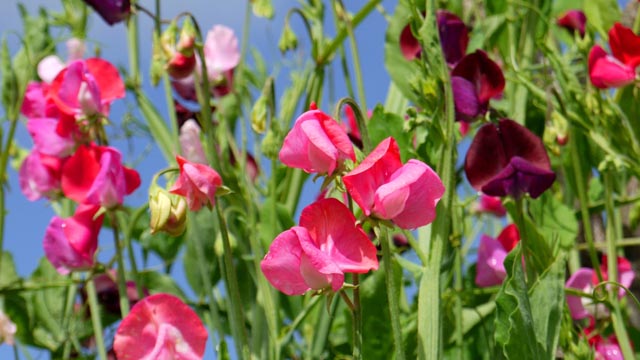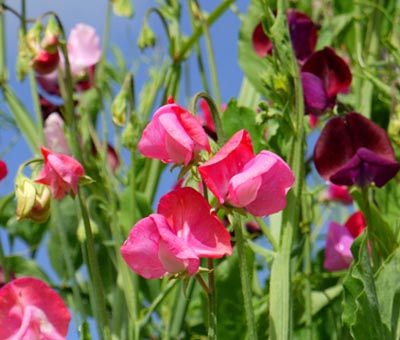The beauty of sweet peas
The sweet pea really is the ultimate summer flower


The gardens are reaching the height of their powers now. Roses are in full bloom, nodding their tousled, scented heads over the grasses in the meadow. The terraces are filled with clover, scabious and knapweed and humming with insect life. The vegetable garden includes young chard leaves and flowering beans. In the Pickery is the flower everybody wants to see and smell, the embodiment of an ecumenical form of gardening: the sweet pea.
These beautiful, romantic flowers are for everyone and nowhere is this truer than in the tale of the Minister of Sprouston. He looked after a poor parish in the Scottish Borders and, like many clerics of the Edwardian era, he enjoyed his garden. In 1911, the Daily Mail launched a competition for the best bunch of sweet peas with a first prize of £1,000. Persuaded by his flock to enter the competition, the minister sent two bunches. Out of 38,000 entries, his flowers won first and third prizes; the chancel he built with the money stands in the village today.
Smaller than modern varieties, late-Victorian and Edwardian sweet peas are still grown for the strength of their scent and they have great charm in the garden. We grow them on round drums of sheep netting, made of a wire narrow enough for the plants to entwine their tendrils through.
By now, they're forming bushes of individual varieties. Edward VII is reliable and a ridiculously bright, deep pink. I find it gently ironic that a sweet pea fit only for Barbara Cartland is named after a man with a great bushy beard. Lord Nelson is a deep, royal-navy blue and looks good with the delicate lavender hue of Mrs Walter Wright or pale-blue Flora Norton.
A newer variety in this group is Lathyrus odoratus Fire and Ice, brought to the market by Lincolnshire grower Mark Rowland. It's well named and the standards (upper petals) are white suffused with red and the wings (lower petals) are edged with a watery, lilac glow.

No list of grandifloras would be complete without the deep-maroon and blue Matucana, famous for its fragrance. It's similar to a variety sometimes sold as Wild Italian or Cupani, but it has an extra flower per stem. Like many sweet peas, Matucana can be moody. Some years, it's slow to germinate; other years, it won't come true. On the other hand, because it's such an old variety, you may find it in your other sweet peas as they try to revert to their past. What you won't lose is its exquisite scent, which seems to persist, no matter how capricious the germination rate or colour.
We also grow some 60 modern cultivars, on upright supports. They all have some scent and produce big, frilly flowers, up to five per stem. These are the ones you want in a bridal bouquet, with a few of the Edwardian flowers tucked around the back to boost the scent. White sweet peas can be particularly floriferous; we like White Frills.
Sign up for the Country Life Newsletter
Exquisite houses, the beauty of Nature, and how to get the most from your life, straight to your inbox.
A subtle and very beautiful sweet pea is Mollie Rilstone, whose limey buds open to a pale pink. It could have been designed by Colefax and Fowler to complement a country-house interior. When in full flower, the peas need regular attention. We remove most of the tendrils and pick the blooms regularly to encourage more. Sweet peas need quite a lot of feeding, so a regular boost with liquid fertiliser is a good idea.
During Sweet Pea Week, our visitors love to walk along the rows, testing the fragrance of each cultivar. Some are definitely stronger than others, but what matters most of all is the strength of the sun. If we have a period of bright sunshine, then the sweet-pea scent can be picked up right across the garden. In dull weather, it can be hard to detect, even with your nose pushed right into the flower. Perhaps that's why we associate sweet peas with the best days of summer?
Ursula Cholmeley owns and runs Easton Walled Gardens, Easton, near Grantham, Lincolnshire (01476 530063; www.eastonwalledgardens.co.uk). Sweet Pea Week, June 29-July 6, 11am-4pm
* Follow Country Life magazine on Twitter
Country Life is unlike any other magazine: the only glossy weekly on the newsstand and the only magazine that has been guest-edited by HRH The King not once, but twice. It is a celebration of modern rural life and all its diverse joys and pleasures — that was first published in Queen Victoria's Diamond Jubilee year. Our eclectic mixture of witty and informative content — from the most up-to-date property news and commentary and a coveted glimpse inside some of the UK's best houses and gardens, to gardening, the arts and interior design, written by experts in their field — still cannot be found in print or online, anywhere else.
-
 'The watch is Head Boy of men’s accessorising': Ginnie Chadwyck-Healey and Tom Chamberlin's Summer Season style secrets
'The watch is Head Boy of men’s accessorising': Ginnie Chadwyck-Healey and Tom Chamberlin's Summer Season style secretsWhen it comes to dressing for the Season, accessories will transform an outfit. Ginnie Chadwyck-Healey and Tom Chamberlin, both stylish summer-party veterans, offer some sage advice.
-
 Lewis Hamilton, Claude Monet and the Four Horsemen of the Apocalypse: Country Life Quiz of the Day, April 29, 2025
Lewis Hamilton, Claude Monet and the Four Horsemen of the Apocalypse: Country Life Quiz of the Day, April 29, 2025Tuesday's Quiz of the Day looks back at Lewis Hamilton's first win and ponders on the meaning of greige.